Journal list menu
Export Citations
Download PDFs
Cover Pictures
Cover Picture: The Mackay-Type Cluster [Cu43Al12](Cp*)12: Open-Shell 67-Electron Superatom with Emerging Metal-Like Electronic Structure (Angew. Chem. Int. Ed. 44/2018)
- Page: 14293
- First Published: 18 October 2018
12: Open-Shell 67-Electron Superatom with Emerging Metal-Like Electronic Structure (Angew. Chem. Int. Ed. 44/2018) Volume 57 Issue 44, 2018](/cms/asset/edc5f6b3-0efc-4b6e-9c36-ec432876a2b7/anie201811547-toc-0001-m.jpg)
The M55 magic-atom-number cluster [Cu43Al12](Cp*)12 features a Mackay-type nested icosahedral core–shell structure, protected by twelve Cp* (Cp*=η-C5(CH3)5) groups. As shown by J.-Y. Saillard, R. A. Fischer, and co-workers in their Communication on page 14630 ff., its open-shell 67 electron superatom configuration features three unpaired electrons occupying weakly antibonding jellium states. The situation prefigures the formation of a conduction band, which is in line with the temperature-independent magnetism.
Inside Cover: Genome-Based Identification of a Plant-Associated Marine Bacterium as a Rich Natural Product Source (Angew. Chem. Int. Ed. 44/2018)
- Page: 14294
- First Published: 15 October 2018
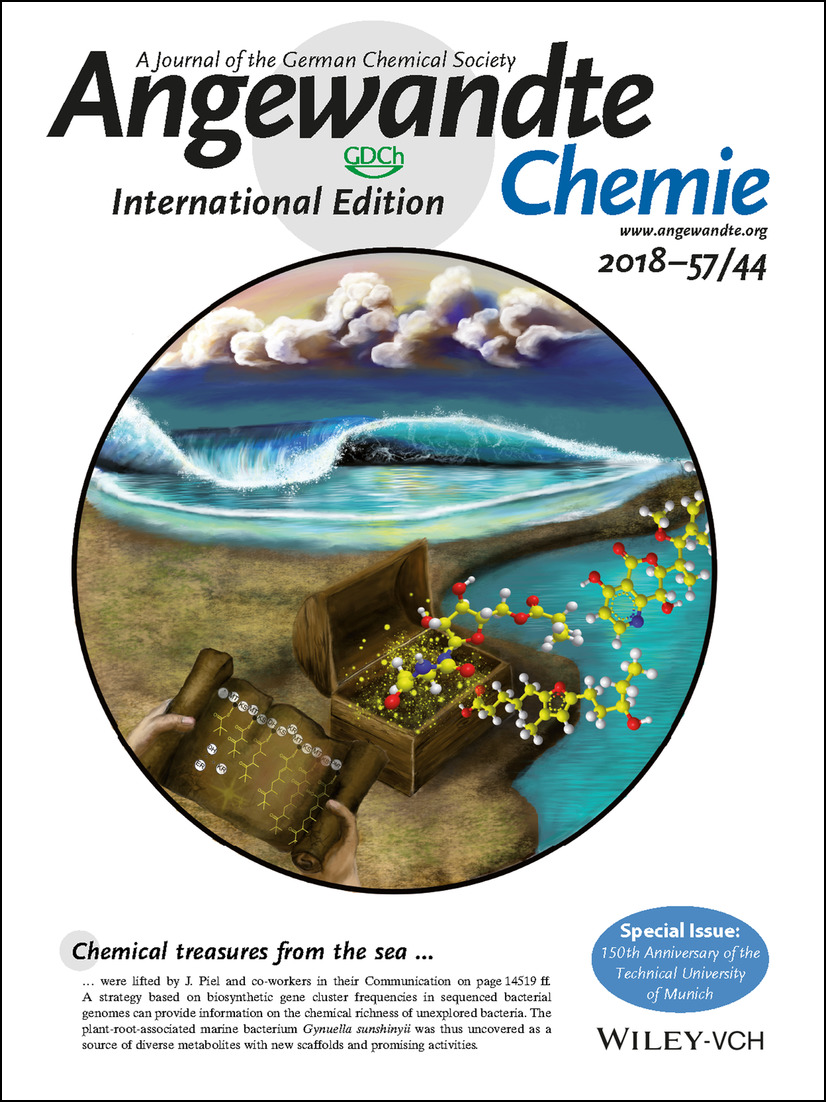
Chemical treasures from the sea were lifted by J. Piel and co-workers in their Communication on page 14519 ff. A strategy based on biosynthetic gene cluster frequencies in sequenced bacterial genomes can provide information on the chemical richness of unexplored bacteria. The plant-root-associated marine bacterium Gynuella sunshinyii was thus uncovered as a source of diverse metabolites with new scaffolds and promising activities.
Inside Back Cover: Reprogramming Human Siderocalin To Neutralize Petrobactin, the Essential Iron Scavenger of Anthrax Bacillus (Angew. Chem. Int. Ed. 44/2018)
- Page: 14655
- First Published: 17 October 2018
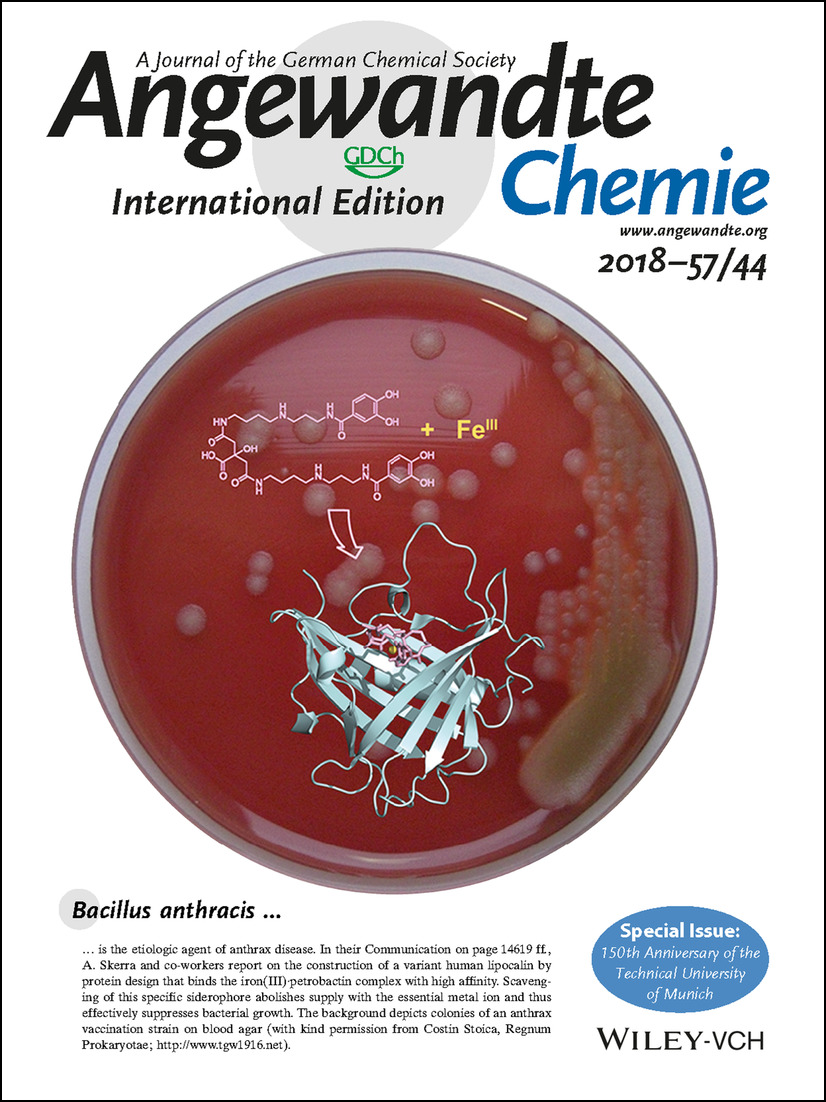
Bacillus anthracis is the etiologic agent of anthrax disease. In their Communication on page 14619 ff., A. Skerra and co-workers report on the construction of a variant human lipocalin by protein design that binds the iron(III)⋅petrobactin complex with high affinity. Scavenging of this specific siderophore abolishes supply with the essential metal ion and thus effectively suppresses bacterial growth. The background depicts colonies of an anthrax vaccination strain on blood agar (with kind permission from Costin Stoica, Regnum Prokaryotae; http://www.tgw1916.net).
Back Cover: Ultrashort Broadband Cooperative Pulses for Multidimensional Biomolecular NMR Experiments (Angew. Chem. Int. Ed. 44/2018)
- Page: 14656
- First Published: 15 October 2018
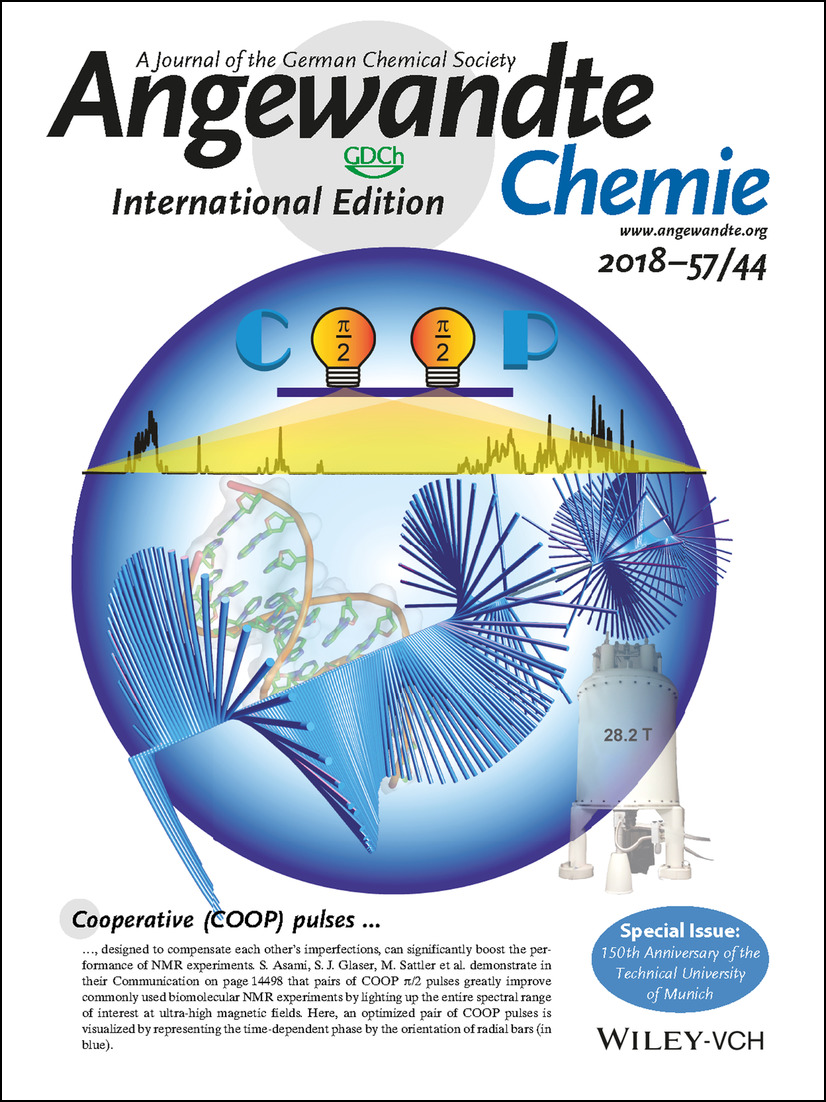
Cooperative (COOP) pulses , designed to compensate each other's imperfections, can significantly boost the performance of NMR experiments. S. Asami, S. J. Glaser, M. Sattler et al. demonstrate in their Communication on page 14498 that pairs of COOP π/2 pulses greatly improve commonly used biomolecular NMR experiments by lighting up the entire spectral range of interest at ultra-high magnetic fields. Here, an optimized pair of COOP pulses is visualized by representing the time-dependent phase by the orientation of radial bars (in blue).
Frontispiece
Frontispiece: Metal-Free Synthesis of Pharmaceutically Important Biaryls by Photosplicing
- First Published: 23 October 2018
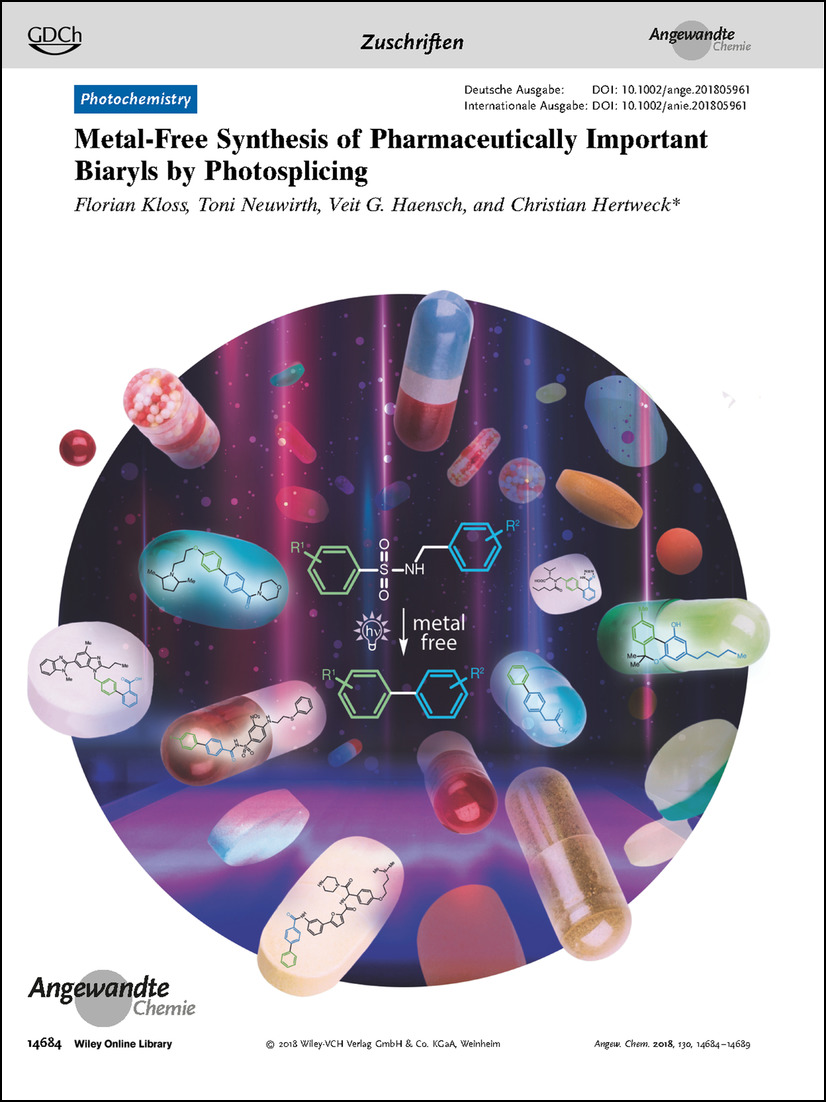
Photochemistry In their Communication on page 14476 ff., C. Hertweck and co-workers report on a metal-free cross-coupling reaction that involves the tethering of two phenyl groups by a temporary, traceless sulfonamide linker.
Frontispiece: Photochemically Driven Reverse Water-Gas Shift at Ambient Conditions mediated by a Nickel Pincer Complex
- First Published: 23 October 2018
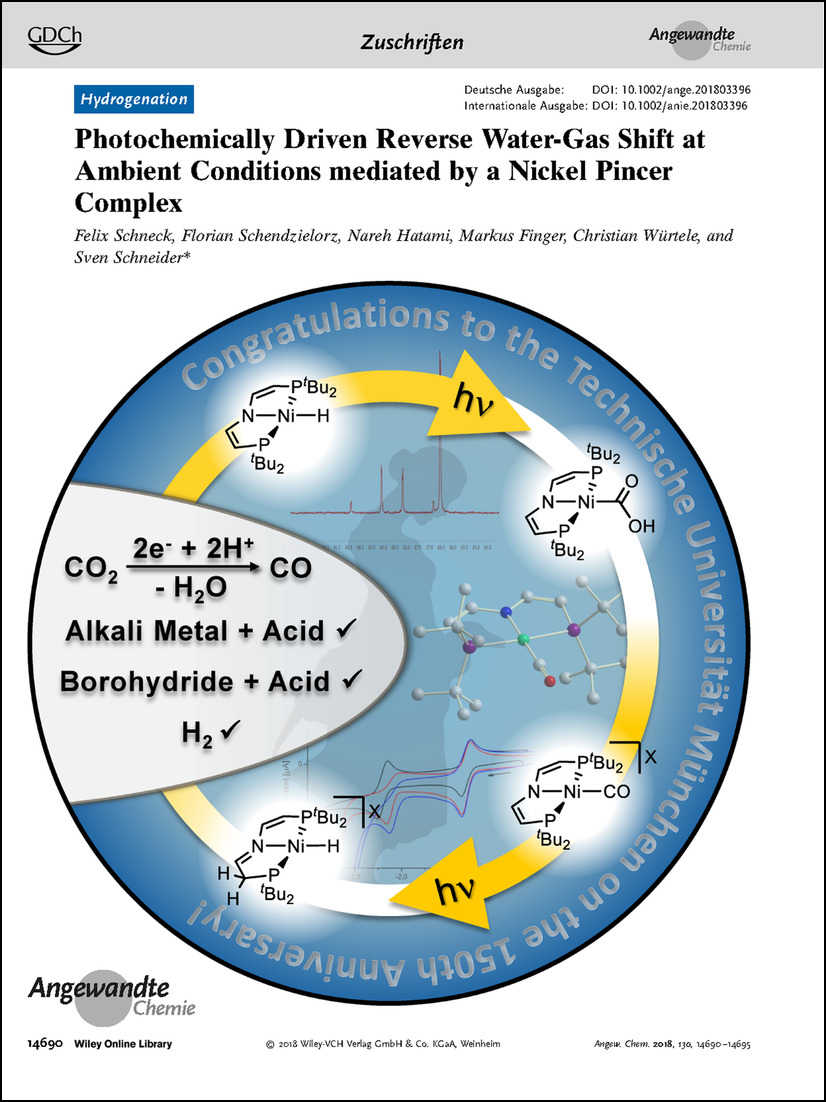
Hydrogenation. S. Schneider and co-workers report in their Communication on page 14482 ff. a reverse water-gas-shift reaction that is mediated by a molecular nickel hydride. This photodriven reaction proceeds under ambient conditions.
Editorial
Editorial: 150 Years of the Technische Universität München: Innovation since 1868
- Pages: 14296-14298
- First Published: 10 October 2018
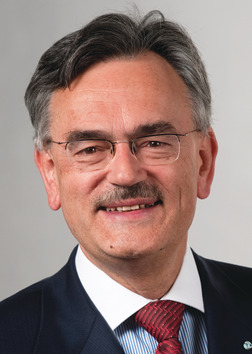
“… On Easter Sunday 1868, the decree founding the Polytechnische Hochschule München (today′s Technische Universität München; TUM) was signed by the 23-year-old Ludwig II, King of Bavaria. Entrepreneurial spirit has been a hallmark of the TUM from the start, and it was the first German university to have a branch abroad. Interdisciplinary research is key, not least in the Department of Chemistry …” Read more in the Guest Editorial by Wolfgang A. Herrmann.
Graphical Abstract
Graphical Abstract: Angew. Chem. Int. Ed. 44/2018
- Pages: 14300-14313
- First Published: 23 October 2018
News
Spotlights on our sister journals: Angew. Chem. Int. Ed. 44/2018
- Pages: 14316-14320
- First Published: 23 October 2018
Author Profile
News
Elected to the Deutsche Akademie der Naturforscher Leopoldina: M. Sattler / Australian Museum Eureka Prizes: T. Maschmeyer and E. J. New / Alfred C. Egerton Gold Medal: K. Kohse-Höinghaus
- Pages: 14325-14326
- First Published: 19 October 2018
Viewpoints
Analytical Chemistry
Analytical Chemistry: Current Trends in Light of the Historic Beginnings
- Pages: 14328-14336
- First Published: 01 April 2018

Back to the future: Selected current developments in analytical chemistry are discussed in this Viewpoint and traced back to original work published up to 150 years ago. Discussed topics include selective mass determination, molecular spectroscopy, chemical sensors, separation methods, and bioinspired receptors such as antibodies.
Minireviews
Photochemistry
Chromophore Activation of α,β-Unsaturated Carbonyl Compounds and Its Application to Enantioselective Photochemical Reactions
- Pages: 14338-14349
- First Published: 28 May 2018
Protein–Protein Interactions
Expanding the Genetic Code to Study Protein–Protein Interactions
- Pages: 14350-14361
- First Published: 24 August 2018

Trapping transient protein–protein interactions: Site-specific incorporation of unnatural amino acids bearing chemical groups that allow covalent crosslinking with molecules in their vicinity provides a powerful tool for mapping weak and transient protein–protein interactions and for defining the structure and topology of protein complexes both in vitro and in vivo.
Sustainable Polymers
Pinenes: Abundant and Renewable Building Blocks for a Variety of Sustainable Polymers
- Pages: 14362-14371
- First Published: 14 May 2018
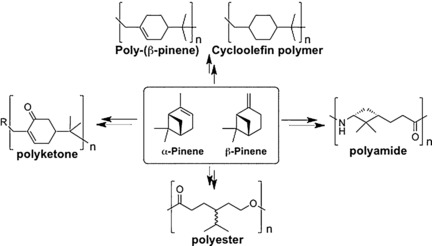
Two isomeric monoterpenes, α-pinene and β-pinene, which can easily be isolated in large scale from different plants (also from non-edible parts of them), can be conveniently transformed into a variety of sustainable polymers and advanced materials. Recent studies on this are summarized in this Minireview with a focus on synthetic strategies and properties of the obtained polymers.
Reviews
Cluster Compounds
Intermetalloid Clusters: Molecules and Solids in a Dialogue
- Pages: 14372-14393
- First Published: 11 August 2018
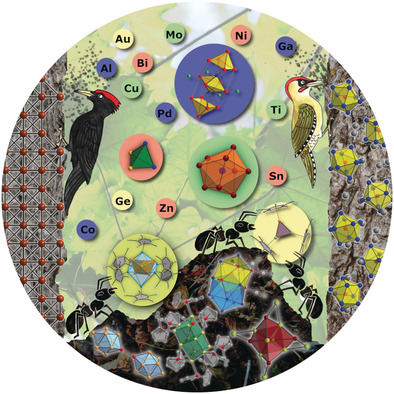
The relationship of molecular intermetalloid clusters and intermetallic compounds reminds us of a complex ecosystem: in our metaphor, woodpecker scientists release in a top-down approach preformed clusters and metal atoms from solid-state trees. Bustling ant chemists collect the falling pieces and transform them into new intermetalloid clusters, which may constitute a fertile soil for new modifications of intermetallic compounds. Cover art: K. Mayer.
Multiple Bonds
Experimental Realisation of Elusive Multiple-Bonded Aluminium Compounds: A New Horizon in Aluminium Chemistry
- Pages: 14394-14413
- First Published: 23 May 2018
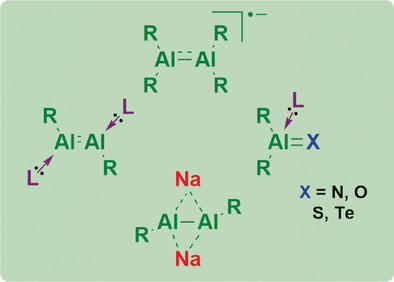
Experimentally challenging and intellectually intriguing, the field of aluminium homo- and heterodiatomic multiply bonded complexes and their reactivity has made signficant progress in recent years. This Review outlines some of the cutting edge synthetic approaches and careful ligand design that have paved the way for this success.
Drug Development
Orally Active Peptides: Is There a Magic Bullet?
- Pages: 14414-14438
- First Published: 24 August 2018
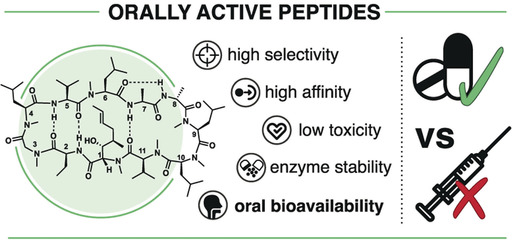
Take up the challenge: The development of orally active peptides is a complex challenge as several requirements are necessary to achieve essential criteria: high selectivity, high affinity, low toxicity, enzymatic stability, and oral bioavailability. The biological background, various chemical modifications, and some successful examples are presented in this Review.
Antibacterial Drugs
Thinking Outside the Box—Novel Antibacterials To Tackle the Resistance Crisis
- Pages: 14440-14475
- First Published: 25 June 2018
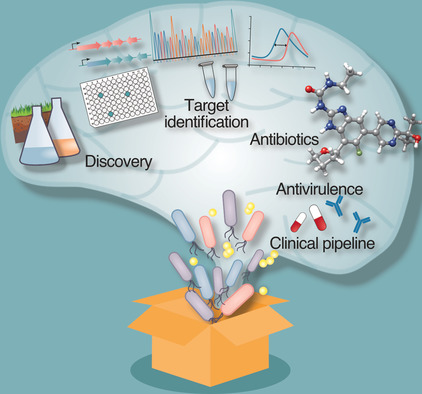
Fit for the future: The discovery of novel antibacterials is a highly interdisciplinary field which relies on input from various research areas. This Review encompasses several aspects of antibiotic development—from very early strategies to mature drugs in clinical trials. An overview is given of methods suitable for mining novel antibacterials and for the elucidation of their bacterial targets.
Communications
Photochemistry
Metal-Free Synthesis of Pharmaceutically Important Biaryls by Photosplicing
- Pages: 14476-14481
- First Published: 12 July 2018
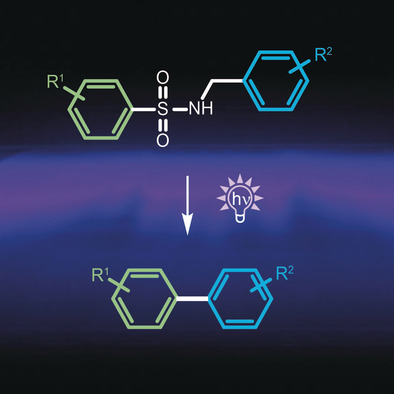
Light on biaryls: A novel metal-free approach to biaryls is reported that involves the tethering and photochemical fusion of phenyl groups through sulfonamides. Using a flow reactor biaryl pharmacophores of numerous therapeutics, antibiotics, antitumor and neuroprotective agents, non-steroidal antiinflammatory drugs, sartans, and cannabinol, were prepared in excellent yields.
Hydrogenation
Photochemically Driven Reverse Water-Gas Shift at Ambient Conditions mediated by a Nickel Pincer Complex
- Pages: 14482-14487
- First Published: 17 May 2018
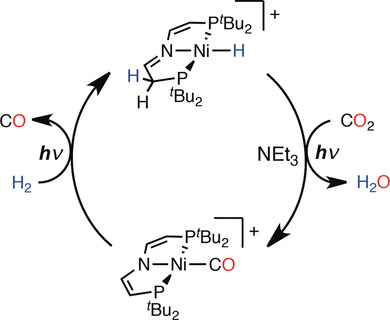
Let there be light: A simple, two-step photodriven reverse-water-gas-shift (rWGS) cycle at ambient temperature and pressure is reported. The CO2 to CO hydrogenation is mediated by a molecular nickel hydride. The reaction relies on photochemical abnormal CO2 insertion into the Ni−H bond and cooperative, heterolytic H2-activation by the metal and the functional pincer ligand.
Heterogeneous Catalysis
Hydrogenation of Pyridines Using a Nitrogen-Modified Titania-Supported Cobalt Catalyst
- Pages: 14488-14492
- First Published: 19 June 2018
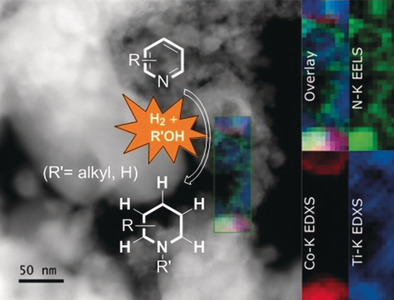
Nitrogen-modified titanium structures: Cobalt catalysts were prepared by impregnation of titania with an aqueous solution of cobalt acetate and melamine. The resulting material has a distinctive nitrogen-modified titanium structure and shows good activity and selectivity for pyridine hydrogenation in water.
Asymmetric Synthesis
Enantioselective Synthesis of the Spirotropanyl Oxindole Scaffold through Bimetallic Relay Catalysis
- Pages: 14493-14497
- First Published: 08 February 2018

Ring, ring: The first enantioselectively catalyzed synthesis of the spirotropanyl oxindole scaffold, which is characteristic of bioactive alkaloids like alstonisine and chitosenine, was developed. The method involves a bimetallic relay catalysis strategy, with a highly enantioselective 1,3-dipolar cycloaddition as the key step.
NMR Spectroscopy
Ultrashort Broadband Cooperative Pulses for Multidimensional Biomolecular NMR Experiments
- Pages: 14498-14502
- First Published: 05 March 2018
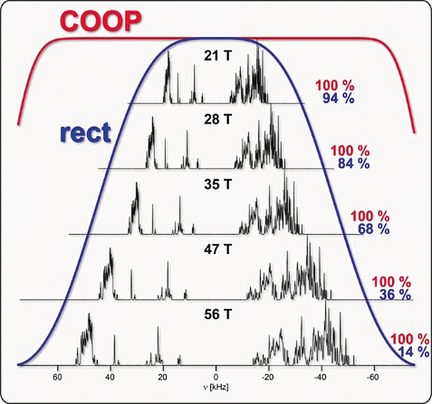
Ultra-highfield NMR magnet development requires robust radio frequency pulses to cover the increasing frequency spectral bandwidth. Cooperative excitation pulses are presented with pulse durations on the order of tens of microseconds, which provide ultrabroadband excitation for present and future magnetic field strengths well beyond 28 T (1.2 GHz 1H). The performance is demonstrated for proteins and nucleic acids.
Alzheimer's Disease
Designed Macrocyclic Peptides as Nanomolar Amyloid Inhibitors Based on Minimal Recognition Elements
- Pages: 14503-14508
- First Published: 16 June 2018
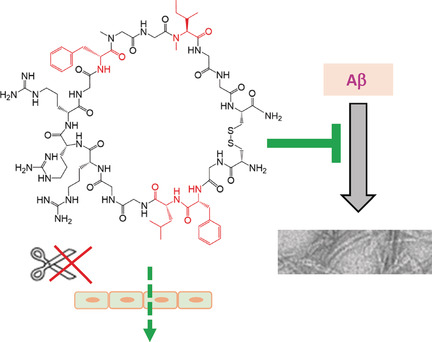
Taking the lead: Amyloid self-assembly is linked to Alzheimer's disease (AD) and type 2 diabetes (T2D). In a minimalistic approach, macrocyclic peptides (MCIPs) were designed as potent amyloid inhibitors of Aβ40(42) and IAPP and a selective MCIP (see structure) for Aβ40(42) with high proteolytic stability in human plasma and blood–brain-barrier-crossing ability in a cell model was discovered. MCIPs are promising leads for amyloid targeting in AD or in both AD and T2D.
Cage Molecules
Synthesis and Reactivity of Multiple Phosphine-Functionalized Nonagermanide Clusters
- Pages: 14509-14513
- First Published: 12 July 2018
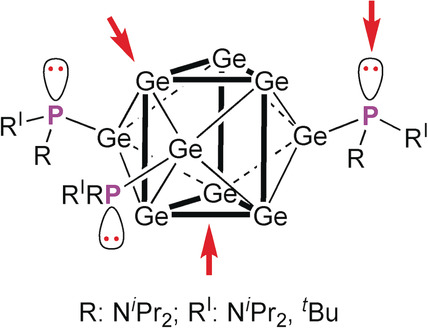
Multifunctional Cluster Compounds: Threefold phosphine-functionalized clusters are easily accessible via one-step synthesis from the Zintl phase K4Ge9. The novel species reveal various reactive sites that can be approached by Lewis acids, comprising the lone pairs at P, single Ge atoms or Ge3 triangular clusters faces (red arrows).
Solid-State NMR Spectroscopy
Overcoming Volume Selectivity of Dipolar Recoupling in Biological Solid-State NMR Spectroscopy
- Pages: 14514-14518
- First Published: 10 July 2018
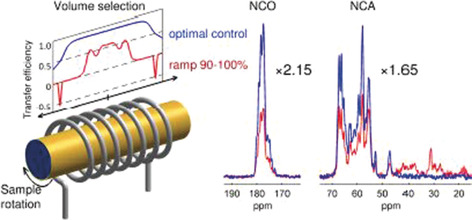
Radiofrequency field inhomogeneity: Heteronuclear dipolar recoupling experiments with substantially larger responsive volume and increased sensitivity compared to the traditional Hartmann–Hahn sequences have been designed using optimal control strategies. Compensation is essential for temporal modulations induced by sample rotation in a spatially inhomogeneous radiofrequency field of a solenoidal coil.
Genome Mining
Genome-Based Identification of a Plant-Associated Marine Bacterium as a Rich Natural Product Source
- Pages: 14519-14523
- First Published: 19 July 2018

Let the sunshine in: A comparison of all published bacterial genomes was conducted to identify novel prolific natural product sources among ecologically and phylogenetically unusual bacteria. This suggested the plant-root-associated halophilic bacterium Gynuella sunshinyii as a top candidate. Its richness was confirmed in an extensive study of its chemical repertoire, revealing diverse metabolites with new scaffolds and promising activities.
G-Quadruplexes
On the Mechanism of Gold/NHC Compounds Binding to DNA G-Quadruplexes: Combined Metadynamics and Biophysical Methods
- Pages: 14524-14528
- First Published: 04 July 2018
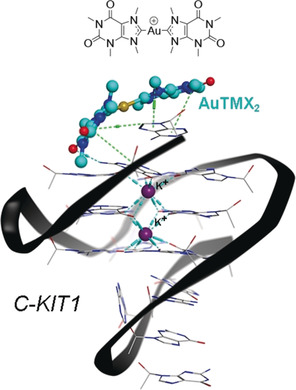
Gold bullet: The binding modes and free-energy landscape of two AuI/N-heterocyclic carbene complexes interacting with G-quadruplexes (G4), namely a human telomeric (hTelo) and a promoter sequence (C-KIT1), are studied here for the first time by metadynamics. The theoretical results are validated by FRET DNA melting assays and provide an accurate estimate of the absolute gold complex/DNA binding free energy.
Borylation
Nickel-Catalyzed Enantioconvergent Borylation of Racemic Secondary Benzylic Electrophiles
- Pages: 14529-14532
- First Published: 05 August 2018

Nickel-catalyzed stereoconvergent cross-couplings of racemic alkyl electrophiles have been expanded to include carbon–heteroatom bond construction for the first time. Specifically, a chiral nickel/pybox catalyst has been shown to borylate benzylic chlorides to produce enantioenriched benzylic boronic esters, a useful family of compounds in organic synthesis.
Catalysis
Low-Coordinated Titanium(III) Alkyl—Molecular and Surface—Complexes: Detailed Structure from Advanced EPR Spectroscopy
- Pages: 14533-14537
- First Published: 27 June 2018
Thin Films
Rhenium Metal and Rhenium Nitride Thin Films Grown by Atomic Layer Deposition
- Pages: 14538-14542
- First Published: 26 July 2018
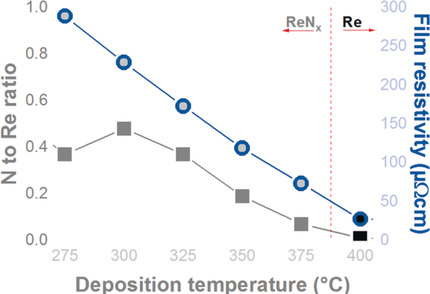
Re-loaded: Highly conductive rhenium and rhenium nitride thin films are deposited at moderate temperatures. The films grow in a highly controllable manner from ammonia and rhenium pentachloride at temperatures up to 500 °C by atomic layer deposition. As thin as 3 nm rhenium film is already continuous and has a low resistivity of 90 μΩ cm.
Oligosaccharides
A Single Route to Mammalian N-Glycans Substituted with Core Fucose and Bisecting GlcNAc
- Pages: 14543-14549
- First Published: 24 August 2018

Core fucosylation on-the-fly: A highly α-selective method was developed for the introduction of α1,6-linked core fucose into N-glycans as the final step. A modular approach based on N-TFAc protection for the antennae provides all the natural combinations of bisecting GlcNAc and core fucose found in mammalian complex-type N-glycans via a single pathway.
N-Heterocyclic Carbenes
Iron and Cobalt Metallotropism in Remote-Substituted NHC Ligands: Metalation to Abnormal NHC Complexes or NHC Ring Opening
- Pages: 14550-14554
- First Published: 04 September 2018
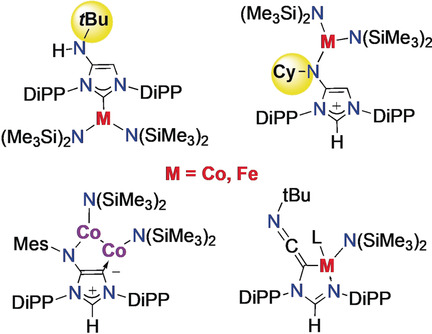
Metallotropism in tautomers arises from stereoelectronic fine-tuning of (Fe or Co){N(SiMe3)2}2 bonding to CNHC or remote N in NHCs/imidazolium salts with amine/aminide substituents, respectively. Thermally induced unexpected formation of a CoI−CoII dinuclear complex and NHC ring opening leading to metallaketenimines were observed.
Hydrogenation
Active Sites on Nickel-Promoted Transition-Metal Sulfides That Catalyze Hydrogenation of Aromatic Compounds
- Pages: 14555-14559
- First Published: 05 September 2018
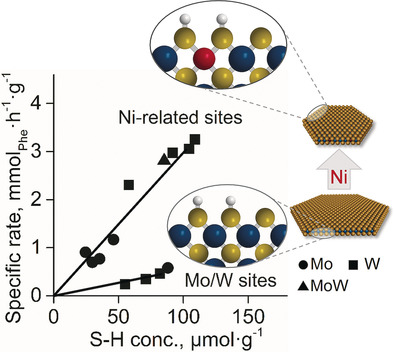
Distinct active sites on MoS2 and WS2 consisting of accessible Mo or W cations and SH groups at the slab edge have been identified. Addition of Ni on both sulfides generates a Ni-(SH)x site that is significantly more active than the sites associated with Mo or W and has a distinct regioselectivity for H-addition. For all sites the ratio between the metal cation and the SH groups is constant.
Amino Acid Synthesis | Hot Paper
A General Amino Acid Synthesis Enabled by Innate Radical Cross-Coupling
- Pages: 14560-14565
- First Published: 13 September 2018

Acids to acids: A practical method for the preparation of highly valuable enantiomerically pure α-amino acids has been developed. The described transformation rapidly converts feedstock alkyl carboxylic acids to α-amino acids, and is enabled by innate radical cross-coupling with a chiral imine radical acceptor. The scope of this transformation is broad and has been field-tested in three different industrial medicinal chemistry laboratories.
Olefin Metathesis
Promoting Terminal Olefin Metathesis with a Supported Cationic Molybdenum Imido Alkylidene N-Heterocyclic Carbene Catalyst
- Pages: 14566-14569
- First Published: 17 September 2018
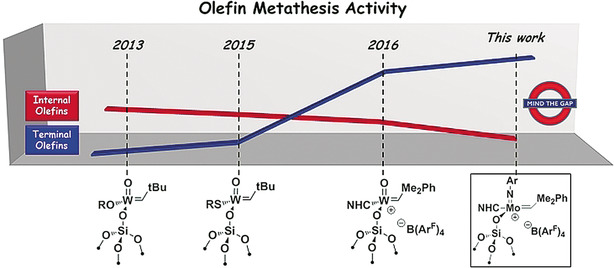
Mind the gap: Silica-supported cationic Mo-imido alkylidene complexes have been developed; these display unusual and contrasting catalytic metathesis activity for internal and terminal olefins, with a strong preference for the latter. The tailored ligand environment also allowed the first supported metallacyclobutane intermediate to be observed.
Borane Chemistry
The Borole Route to Reactive Pentafluorophenyl-Substituted Diboranes(4)
- Pages: 14570-14574
- First Published: 12 September 2018
Silicon Compounds
Precise Activation of Ammonia and Carbon Dioxide by an Iminodisilene
- Pages: 14575-14579
- First Published: 19 June 2018

In pursuit of precision: The double donor–acceptor-type Si=Si bond of a (Z)-imino(silyl)disilene was exploited to selectively activate NH3, leading to the corresponding trans-1,2-adduct under kinetic and the monomeric aminosilane under thermodynamic reaction control. Furthermore, its reactivity toward Lewis acid B(C6F5)3 and the oxygen-atom transfer agents N2O, O2, and CO2 was elucidated.
C−H Activation
Regiospecific ortho-C−H Allylation of Benzoic Acids
- Pages: 14580-14584
- First Published: 07 February 2018

Direct play: A carboxylate-directed ortho-allylation of benzoic acids is achieved in the presence of [Ru(p-cymene)Cl2]2. The reaction is based on widely available, structurally diverse (hetero)aromatic carboxylate substrates and proceeds under remarkably mild reaction conditions. It is widely applicable to (hetero)aromatic benzoic acids and the products can be transformed in situ by acyloxylation, double-bond isomerization, or protodecarboxylation.
Microporous Materials | Very Important Paper
Carving Out Pores in Redox-Active One-Dimensional Coordination Polymers
- Pages: 14585-14588
- First Published: 19 September 2018
Supramolecular Catalysis
Brønsted Acid-Catalyzed Carbonyl-Olefin Metathesis inside a Self-Assembled Supramolecular Host
- Pages: 14589-14592
- First Published: 20 December 2017

Metathesis inside a host: A supramolecular host was used to develop a general method for Brønsted acid-catalyzed carbonyl–olefin metathesis. This system provides comparable yields to the current Lewis acid benchmark catalyst. A mechanistic study indicated stepwise oxetane formation for some of the employed substrates.
Photochemistry
Enantioselective Lewis Acid Catalyzed ortho Photocycloaddition of Olefins to Phenanthrene-9-carboxaldehydes
- Pages: 14593-14596
- First Published: 18 September 2018
Ferrocene Derivatives
A Ferrocene-Based Dicationic Iron(IV) Carbonyl Complex
- Pages: 14597-14601
- First Published: 03 September 2018
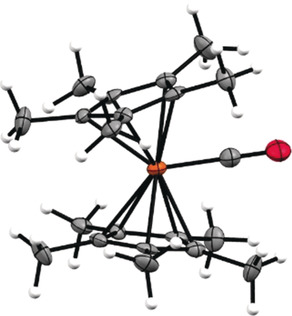
The classical iron carbonyl complex [Cp*2Fe(CO)](AsF6)2, containing formally tetravalent iron, has been prepared by treating [Cp*2Fe]2+ with carbon monoxide in anhydrous HF. The complex was characterized by various spectroscopic techniques, including 57Fe Mössbauer spectroscopy and DFT computational analysis.
Activators
Selective Activation of Human Caseinolytic Protease P (ClpP)
- Pages: 14602-14607
- First Published: 21 August 2018
Self-Assembly
Dissipative Self-Assembly of Photoluminescent Silicon Nanocrystals
- Pages: 14608-14612
- First Published: 24 July 2018
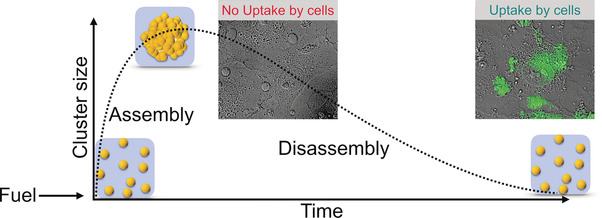
Come together: The dissipative self-assembly of silicon nanocrystals (SiNCs) is coupled to a fuel-driven chemical reaction network, thereby enabling kinetic control over the self-assembled structures. For example, the amount of fuel determines the lifetime of the assemblies. Using this mechanism, the uptake of SiNCs by cells could be delayed.
Methane Dry Reforming on PdZr
Zirconium-Assisted Activation of Palladium To Boost Syngas Production by Methane Dry Reforming
- Pages: 14613-14618
- First Published: 04 September 2018
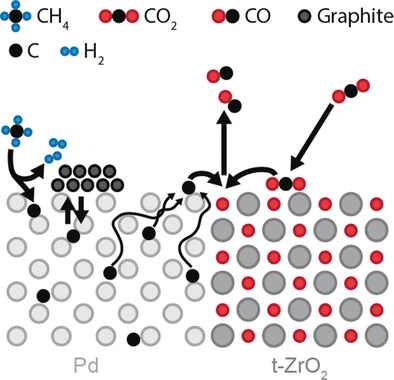
ZrO2-promoted methane dry reforming on PdxC: C-saturated Pd0 nanoparticles with extended phase boundary to ZrO2 evolve from a Pd0Zr0 precatalyst under CH4 dry reforming conditions. This highly active catalyst state fosters bifunctional action: CO2 is efficiently activated at oxidic phase boundary sites and PdxC provides fast supply of C-atoms toward the latter.
Siderophores
Reprogramming Human Siderocalin To Neutralize Petrobactin, the Essential Iron Scavenger of Anthrax Bacillus
- Pages: 14619-14623
- First Published: 31 July 2018
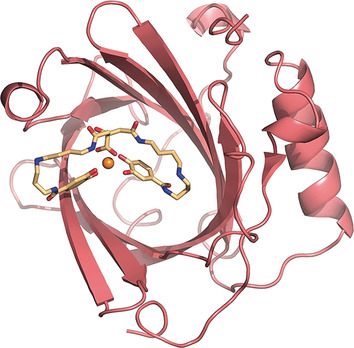
High-affinity molecular recognition of metal-complexed petrobactin, a specific siderophore of Bacillus anthracis, was achieved with an engineered human lipocalin protein that normally scavenges enterobactin and bacillibactin to control the systemic spreading of bacteria by restricting iron supply. The picture shows the crystal structure of the petrocalin/petrobactin⋅GaIII complex.
Iron Metabolism
Iron Scavenging in Aspergillus Species: Structural and Biochemical Insights into Fungal Siderophore Esterases
- Pages: 14624-14629
- First Published: 01 August 2018

Breaking the cage: Fungi use siderophores to scavenge Fe3+ from the environment. Intracellular iron release occurs through hydrolysis of the siderophore backbone by esterases. Structural and biochemical analyses of two homologous EstB esterases, as well as EstA and SidJ, reveal how a common fold adapts to diverse substrates. A structure of an active enzyme in complex with its siderophore substrate reveals a tetrahedral intermediate at the catalytic serine.
Cluster Chemistry | Very Important Paper
The Mackay-Type Cluster [Cu43Al12](Cp*)12: Open-Shell 67-Electron Superatom with Emerging Metal-Like Electronic Structure
- Pages: 14630-14634
- First Published: 07 July 2018
12: Open-Shell 67-Electron Superatom with Emerging Metal-Like Electronic Structure](/cms/asset/983a0e7e-5586-4c5e-8a5f-ea20c8186a8e/anie201806039-toc-0001-m.jpg)
Superatomic: The reaction of [AlCp*]4 and [CuMes]5 yields the Mackay 55-metal atom two-shell icosahedral cluster [Cu43Al12](Cp*)12. The intermetalloid cluster has a unique 67-electron open-shell superatomic [Cu43Al12]12+ core, embedded inside an all-hydrocarbon shell of twelve Cp*− ligands. Its electronic structure comprises a set of entangled HOMO und low-lying LUMOs, prefiguring the formation of a conduction band.
Methane Activation
The Electric Field as a “Smart” Ligand in Controlling the Thermal Activation of Methane and Molecular Hydrogen
- Pages: 14635-14639
- First Published: 10 June 2018
Heteropolyhalogen Cations
Drug Design
From a Helix to a Small Cycle: Metadynamics-Inspired αvβ6 Integrin Selective Ligands
- Pages: 14645-14649
- First Published: 16 April 2018
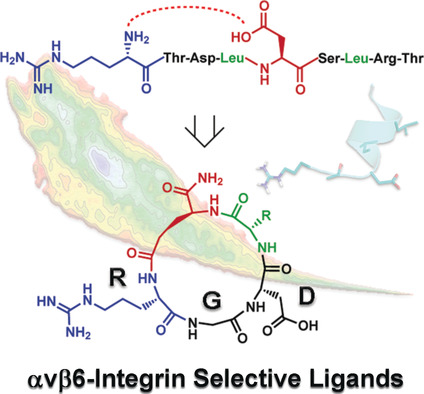
A metadynamics-driven drug design strategy was employed to transform a helical nonapeptide into a cyclic pentapeptide as a potent and selective ligand of the RGD-recognizing αvβ6 integrin. This compound was further developed into a PET tracer for specific αvβ6-mapping in vivo, prompting its use for cancer diagnosis and therapy.
Total Synthesis
Chemo-enzymatic Total Synthesis of Oxosorbicillinol, Sorrentanone, Rezishanones B and C, Sorbicatechol A, Bisvertinolone, and (+)-Epoxysorbicillinol
- Pages: 14650-14653
- First Published: 23 May 2018
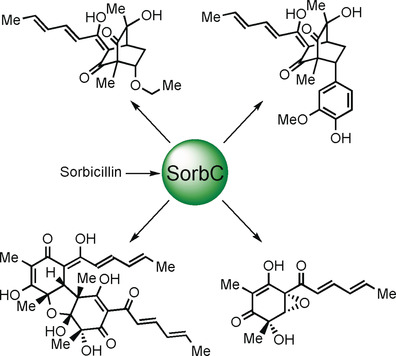
Sorbicillinoids made easy: The first stereoselective total syntheses of the structurally diverse sorbicillinoids oxosorbicillinol, sorrentanone, rezishanones B and C, sorbicatechol A, bisvertinolone, and (+)-epoxysorbicillinol are based on a unified chemo-enzymatic approach that involves a regio- and enantioselective oxidative dearomatization of sorbicillin-type precursors harnessing the catalytic activity of the monooxygenase SorbC.





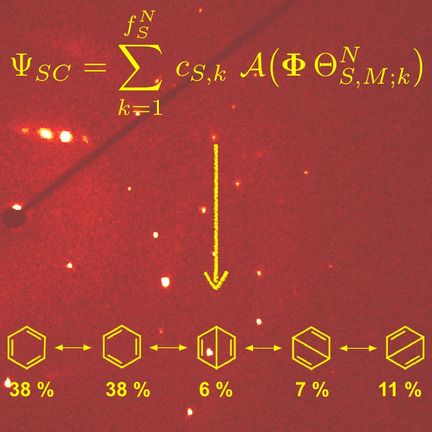









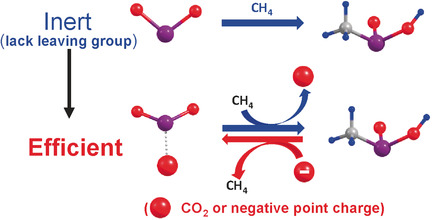
![The Interhalogen Cations [Br2F5]+ and [Br3F8]+](/cms/asset/e4752848-78ca-43ca-86b9-3e4db8ace84f/anie201803708-toc-0001-m.jpg)


































